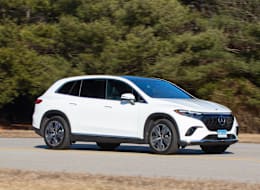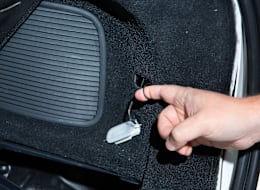Like the fully-electric EQS sedan we also tested, the Mercedes-Benz EQS SUV is quick, quiet, and luxurious. Its optional third-row seat is a rarity among electric SUVs. It earned a high road-test score, but its Overall Score is hurt by Mercedes’ brand reliability. Plus, its unnervingly spongy brake pedal and distracting controls create daily frustrations.
The EQS 450 4Matic version we tested has two motors, which accounts for its all-wheel-drive designation. It has an estimated driving range of 285 miles according to the EPA, which is pretty decent for a large, luxury EV. With its 9.6-kilowatt onboard charger, it can replenish the large, 108.4-kilowatt-hour battery at home at a rate of about 25 miles of range per hour. Its competitive 200-kW max acceptance rate makes for relatively short stops at public DC fast-charging stations—we gained 170 miles of range during a 30 minute stop at an Electrify America venue.
The EQS SUV's 355 horsepower helps it to accelerate effortlessly, zipping from 0 to 60 mph in just 5.6 seconds. We like the ability to adjust the regenerative-braking levels with the steering wheel paddles, ranging from no regen so that you’re coasting like a normal car to maximum regen that allows for what’s known as “one-pedal driving,” meaning you can come to a stop by modulating the accelerator without ever touching the physical brake pedal. But when you need to slow down in a hurry, the brake pedal’s long travel and mushy feel can be disconcerting and hurts driver confidence. That said, dry stopping distances in our tests were short.
The standard air suspension brings a comfortable and serene ride, ensuring a relaxed cruise. But the ride is marred by some side-to-side occupant jostling and impact harshness on low-speed ravaged urban streets, likely due to the low-profile tires.
Handling is surprisingly agile for such a burly vehicle, with a quick turn-in response and very little body roll during normal driving. The steering has a nice heft to it, and it conveys some feedback to the driver about tire grip and road texture. The four-wheel steering system, which turns the rear wheels in the same direction as the front wheels at higher speeds, and up to 10 degrees in the opposite direction at lower speeds, is a big help in tight parking situations--and makes for a fun party trick because it's fun to watch.
On our track, we found that this big SUV doesn’t exactly lend itself to sporty driving. It’s too heavy and wide for tackling challenging curves with vigor, and its overly intrusive electronic stability-control (ESC) tuning made the SUV reluctant through our avoidance maneuver test.
The EQS SUV is supremely quiet, even giving one of the most silent cars in our testing—the BMW iX—a run for its money. We noticed very little road and wind noise, and just a bit of tire noise at lower speeds.
We were dazzled by the fine fit and finish of the SUV’s interior. Details include high-quality fabrics, brushed aluminum trim, exposed contrasting stitching, and the very cool looking turbine-like air vents on the dash. But we were a bit surprised that our nearly $112,000 test model has such hard surfaces on the center console where the driver’s right knee comes in contact with it, and the rough edges on the interior door pulls.
We found the front seats mostly comfortable, though some drivers wished the bottom cushion had more thigh support and larger side bolsters. The second-row seats are nicely contoured and maintain great support over long trips. The third-row seat has tight headroom and a seatback that doesn’t recline.
But, by far, the biggest stumbling block of the EQS SUV is its frustrating controls. A majority of the vehicle’s functions require wading into the infotainment touchscreen, which is packed with an overwhelming amount of information. Some of the slide-action steering wheel controls also require a deft touch and can be distracting. Buyers should brace themselves to take on a substantial learning curve to master even simple tasks.
Automatic emergency braking with pedestrian and cyclist detection, automatic emergency braking that operates at highway speeds, blind spot warning, rear cross traffic warning, reverse automatic emergency braking, lane centering assistance, lane departure warning, lane keeping assistance, adaptive cruise control, and automatic high beams all come standard. The adaptive cruise control has an automatic lane-changing ability which is convenient.


























